We often rush through our hallways without a second thought, treating them as nothing more than passages from one room to another. But these transitional spaces hold untapped potential to become some of the most character-filled areas in our homes. A thoughtfully decorated hallway doesn’t just look good—it can transform the entire feel of your home, creating a cohesive flow between rooms while making a statement all its own.
According to a 2023 survey by the American Society of Interior Designers, hallways are among the most overlooked spaces in home design, with 78% of homeowners admitting they’ve never properly decorated these areas. Yet these same transitional spaces account for up to 12% of a home’s total square footage—valuable real estate that deserves your attention!
“Hallways are the threads that stitch together the fabric of your home,” says interior designer Maria Rodriguez. “When decorated thoughtfully, they stop being mere passageways and become destinations that tell your home’s story.”
In this comprehensive guide, we’ll explore twenty innovative ways to transform your hallway walls from bland to grand, combining both style and functionality to make the most of these often-neglected spaces.
Understanding Your Hallway’s Potential
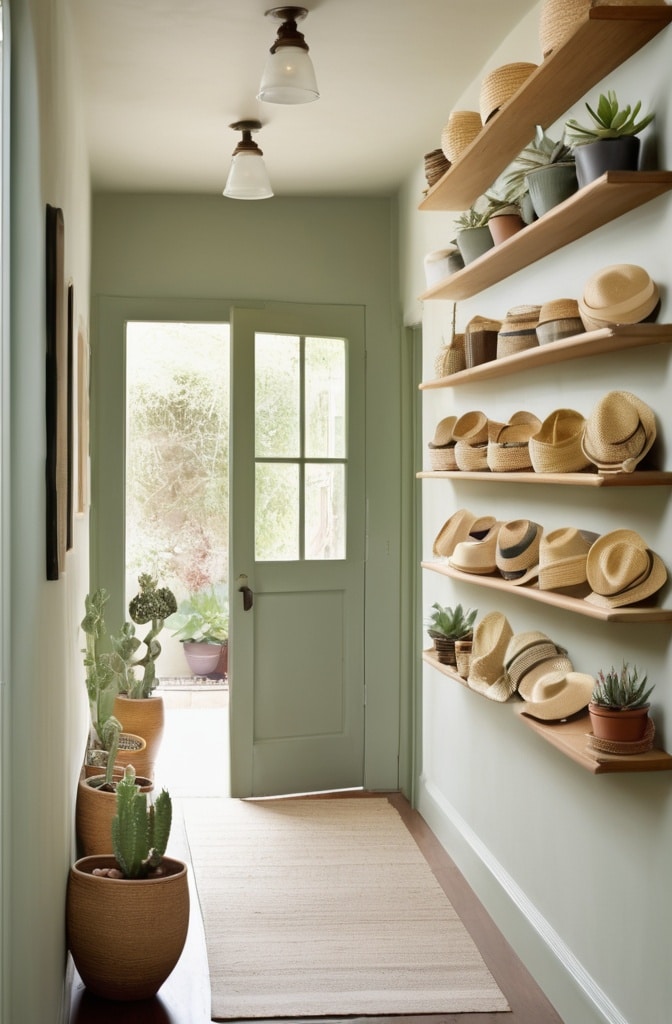
Before diving into specific decorating ideas, it’s important to assess what you’re working with and what you want to achieve.
Analyzing Your Hallway Architecture
Take a good look at your hallway’s dimensions and architectural features:
- Width: Narrow hallways (under 4 feet wide) require different treatment than wider ones
- Length: Short hallways benefit from different visual tricks than long corridors
- Ceiling height: High ceilings offer vertical decorating opportunities
- Natural light: Hallways with windows versus those without affect your decor choices
- Architectural features: Note any existing moldings, alcoves, or built-ins
“The first step in any successful hallway transformation is honest assessment,” explains architect Thomas Chen. “Understand your space’s constraints and opportunities before making any design decisions.”
Identifying Problem Areas and Opportunities
Common hallway challenges include:
- Dark, tunnel-like appearance
- Cramped, narrow dimensions
- Lack of storage
- High traffic wear and tear
- Awkward transitions between rooms
- Blank, characterless walls
Each of these challenges can be addressed with strategic wall decor choices. What might seem like a problem area could actually be your greatest opportunity for creative expression!
The Golden Ratio for Hallway Wall Decor
Interior design professionals often recommend following a balanced approach to hallway wall decor. The “golden ratio” suggests:
- 60% of wall space for larger anchoring elements (mirrors, statement art)
- 30% for medium-sized functional or decorative pieces (shelves, smaller art)
- 10% for small accents and personal touches
This balance ensures your hallway feels neither empty nor cluttered—particularly important in these high-traffic areas where flow is essential.
Mirror Magic: Reflection Strategies for Visual Expansion

Mirrors are perhaps the most powerful tool in your hallway decorating arsenal, especially for smaller spaces that need visual expansion.
Strategic Mirror Placement
Where you position mirrors matters as much as which ones you choose:
- Opposite windows: Maximizes natural light reflection
- At the end of narrow hallways: Creates the illusion of extended space
- Across from decorative elements: Multiplies visual interest
- At eye level: Creates the most natural reflection (typically 57-65 inches from floor center)
Research from the Interior Design Institute shows that strategically placed mirrors can make spaces appear up to 30% larger to the human eye—a significant psychological effect in narrow corridors.
Style-Specific Mirror Selection
The frame and style of your mirror should complement your home’s overall aesthetic:
- Modern homes: Frameless mirrors or simple metal frames
- Traditional spaces: Ornate gilded or carved wooden frames
- Industrial style: Mirrors with metal rivets or factory window designs
- Coastal decor: Rope or weathered wood frames
- Eclectic spaces: Vintage or mismatched collection of smaller mirrors
Designer Sarah Williams notes, “Your mirror’s frame is just as important as the reflection itself. It acts as art even while performing its space-expanding function.”
Creative Alternatives to Traditional Wall Mirrors
Think beyond the basic rectangular mirror:
- Sunburst designs add decorative flair while reflecting light
- Mirrored gallery walls featuring multiple small mirrors in various shapes
- Antiqued or smoky glass for vintage character
- Backlit mirrors that serve as both decor and lighting
- Mirrored tiles arranged in geometric patterns
A particularly effective approach in 2025 is the “broken plan” mirror arrangement, where mirrors of similar style but different sizes are arranged to create the impression of architectural elements like windows.
The Art of the Gallery Wall in Hallways
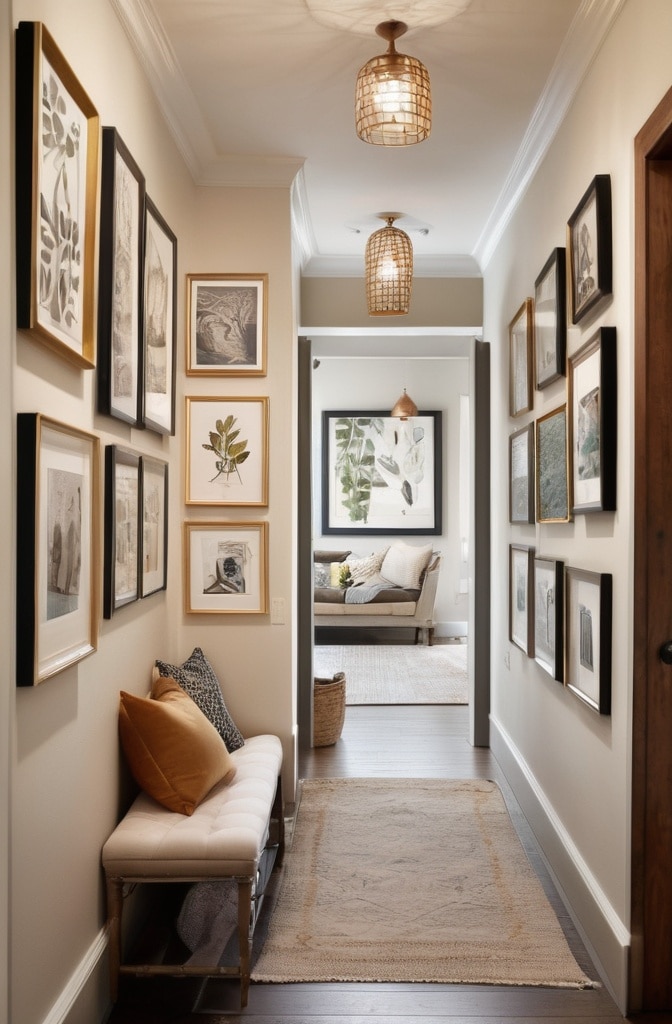
Gallery walls remain one of the most popular and versatile hallway decorating options, allowing for personal expression while adding visual interest to otherwise plain walls.
Planning Principles for Cohesive Gallery Displays
A successful gallery wall requires planning:
- Choose a unifying element: Could be matching frames, a color scheme, or thematic content
- Create a template: Use kraft paper to plan your arrangement before hanging
- Maintain consistent spacing: Generally 2-3 inches between frames looks best
- Consider traffic flow: Keep bottom frames high enough to avoid bumping
“The best gallery walls tell a visual story,” says curator Miranda Lopez. “They shouldn’t be random collections but thoughtful arrangements that guide the eye and spark conversation.”
Asymmetrical vs. Grid Arrangements
Different layout styles create different effects:
Grid Style:
- Creates formal, orderly impression
- Works well with matching frames
- Best for collections of similarly sized pieces
- Creates a sense of calm and organization
Asymmetrical/Salon Style:
- More dynamic and casual feeling
- Accommodates various sizes and shapes
- Easier to add to over time
- Creates more visual energy
A 2024 Pinterest trends report showed asymmetrical gallery walls gaining popularity, with saves for “organic gallery wall” up 112% year over year.
Mixed-Media Gallery Wall Strategies
Contemporary gallery walls often incorporate more than just framed photos:
- Wall sculptures and 3D objects
- Woven wall hangings and textiles
- Small shelves displaying objects among the frames
- Mounted plants or botanical elements
- Letters, signs, or typographic elements
Interior stylist Jason Kim recommends, “Include at least three different types of media in a gallery wall to create depth and interest. This prevents the arrangement from feeling flat or predictable.”
Functional Wall Storage That Enhances Design
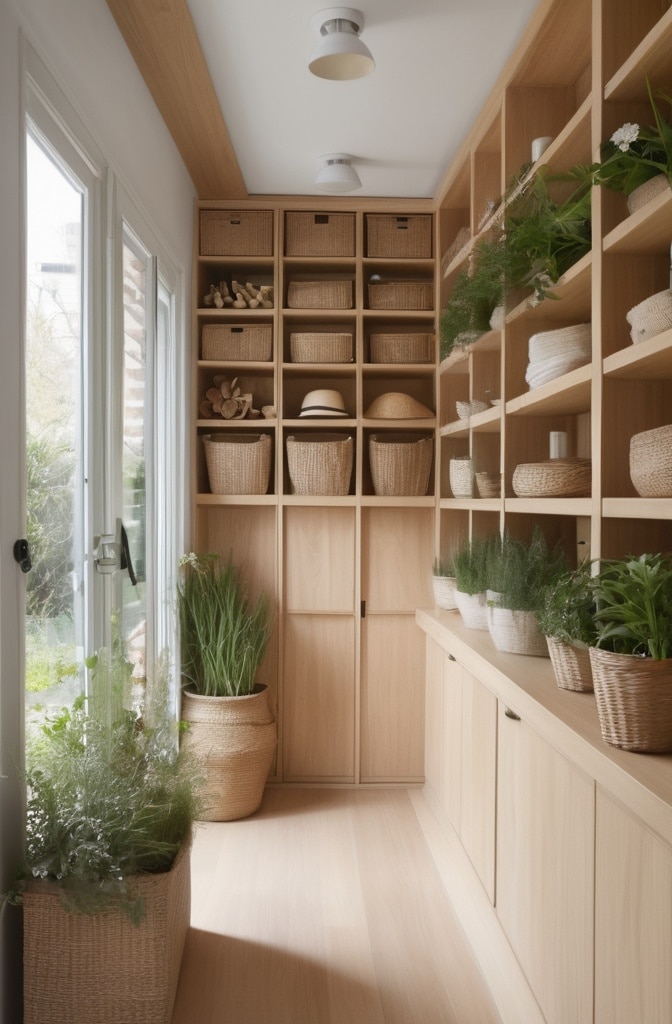
Smart hallway design merges beauty with practicality, and nothing accomplishes this better than decorative storage solutions.
Floating Shelves: Placement and Styling Strategies
Floating shelves offer display space without the visual heaviness of traditional bookcases:
- Install at varying heights to create visual rhythm
- Consider depth carefully: 4-6 inches deep is typically sufficient for hallways
- Materials matter: Choose finishes that complement other hallway elements
- Style in odd numbers: Groups of three or five objects create balanced arrangements
- Include negative space: Don’t overcrowd shelves in narrow passages
According to storage designer Rebecca Thompson, “Hallway shelving should be 30% functional, 70% decorative. Unlike kitchen or office shelving, the aesthetic component takes priority in transitional spaces.”
Decorative Hook Systems
Hooks can be both practical and attractive:
- Decorative wall hooks available in countless design styles
- Hook rails with shelf above for additional functionality
- Vintage repurposed items like antique doorknobs or industrial fixtures
- Clustered hook arrangements that become decorative features
- Hidden hooks behind decorative panels for cleaner aesthetics
A clever approach gaining popularity is the “zone system,” where hooks are installed at different heights for different family members, often with personalized markers or colors.
Wall-Mounted Drop Zones
Small hallway command centers keep everyday essentials organized:
- Mail sorters with key hooks below
- Slim console alternatives that mount directly to walls
- Floating entry cabinets for sunglasses, wallets, and phones
- Charging stations integrated into wall fixtures
- Message centers with small writing surfaces
“The most successful hallway storage solutions are those that encourage daily use through smart placement and intuitive design,” notes organizational expert David Lee. “If it’s not convenient, family members simply won’t use it.”
Color Psychology for Hallway Walls
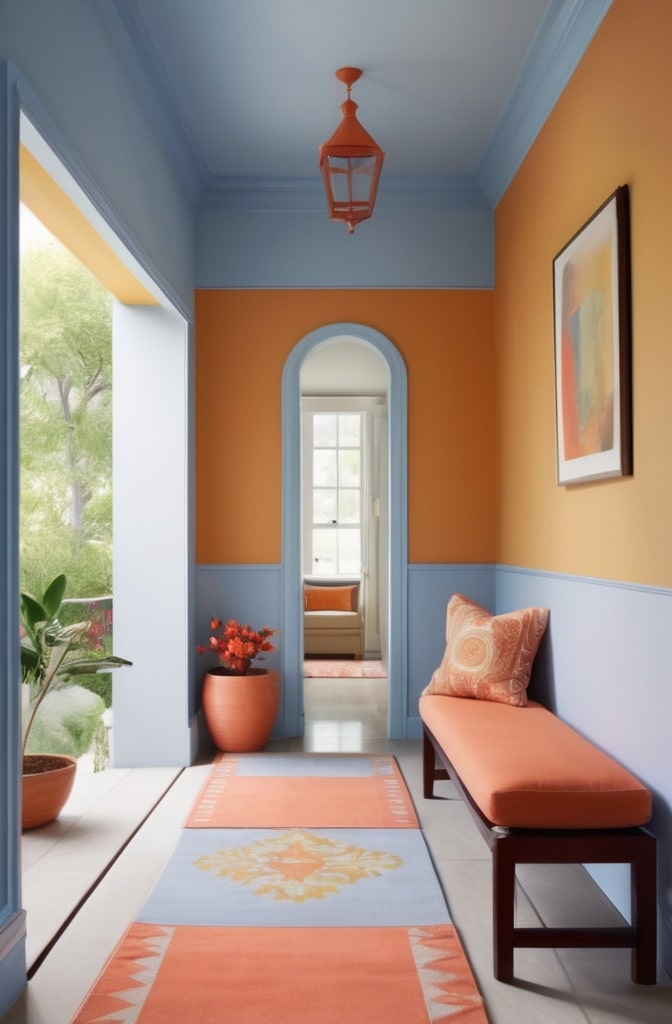
Color choices significantly impact how we perceive hallway dimensions and how we feel when moving through these spaces.
Impact of Color on Perceived Dimensions
Strategic color selection can visually transform your hallway:
- Light colors (white, cream, pale gray) make spaces feel bigger and brighter
- Cool tones (soft blues, greens) can make walls appear to recede
- Warm tones (terracotta, gold) create feelings of coziness but can make spaces feel smaller
- Dark colors can create drama but need adequate lighting
Research from the Color Association of the United States indicates that spaces painted in light colors are perceived as up to 25% larger than identical spaces in darker hues.
Best Color Strategies for Different Lighting Conditions
Match your color choices to your hallway’s natural light situation:
For well-lit hallways:
- The full spectrum of colors works, from light to dark
- Consider how natural light changes throughout the day
- Experiment with more saturated or complex colors
For dark or windowless hallways:
- Opt for colors with higher Light Reflectance Values (LRV)
- Consider slightly warmer whites to prevent sterile feelings
- Add gloss or pearl finishes to enhance light reflection
“Paint colors that might seem too bright in a living room or bedroom often work perfectly in hallways with limited natural light,” explains color specialist Elena Martinez. “These transitional spaces can handle more vibrant choices without becoming overwhelming.”
Accent Wall Placement
Strategic accent walls can transform hallway proportions:
- Painting the end wall of a long hallway in a darker shade makes it appear closer
- Accent walls on the long sides can make narrow hallways feel wider
- Ceiling accent colors draw the eye upward, creating the illusion of height
- Paint color transitions can define different zones in longer hallways
The 2025 trend report from Sherwin-Williams highlights “color blocking” as a growing hallway trend, with homeowners using geometric paint patterns to create visual interest without additional decor.
Textural Dimensions: Beyond Flat Wall Surfaces
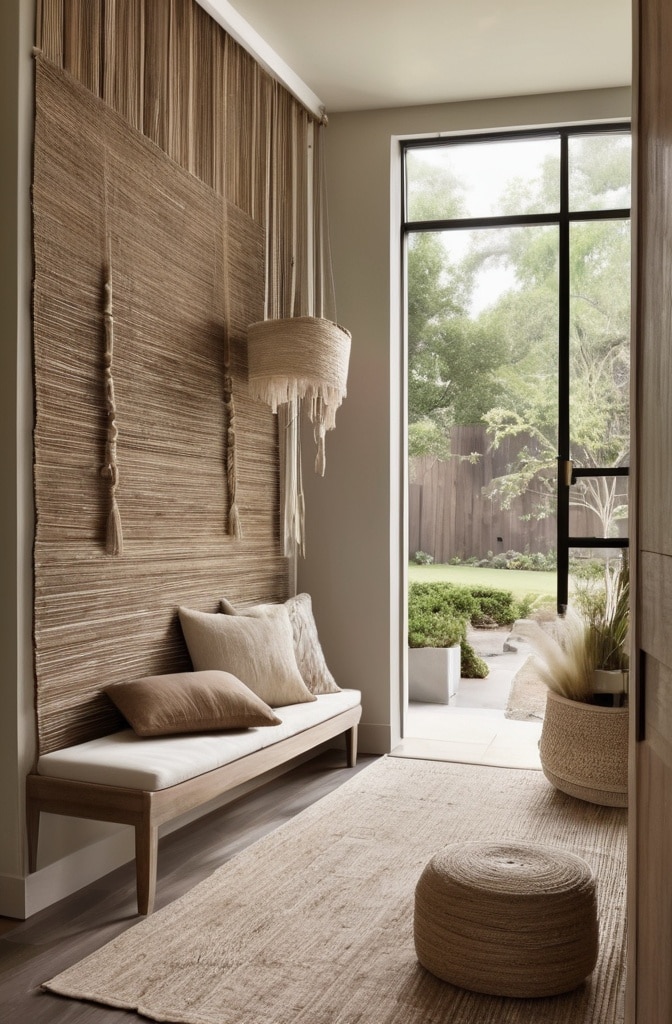
Adding texture to hallway walls creates visual interest through dimension and shadow play without taking up precious floor space.
Shiplap Installation: DIY vs. Professional
Shiplap continues to be popular for adding character to hallways:
DIY Considerations:
- Relatively straightforward installation with basic tools
- Cost: approximately $1.50-$2.50 per square foot for materials
- Time commitment: weekend project for average hallway
- Pre-painted options available for easier installation
Professional Installation Benefits:
- Perfect seams and corners
- Cost: $5-10 per square foot including labor
- Usually completed in 1-2 days
- Often includes repair of underlying wall issues
Designer Joanna Stevens shares, “Horizontal shiplap can make narrow hallways appear wider, while vertical installation draws the eye up, emphasizing ceiling height. This simple orientation choice dramatically affects spatial perception.”
Reclaimed Wood Panels
Adding character through history-rich materials:
- Sources include old barns, factories, and salvage yards
- Cost varies widely ($5-25 per square foot) depending on wood type and condition
- Consider sealed options for easier cleaning in high-traffic areas
- Lighter wood tones work best in narrower spaces
- Mix with painted elements for balanced visual weight
A 2024 sustainability report found that using reclaimed wood in home design reduced environmental impact by up to 13 times compared to new lumber while adding approximately 15% to property values due to character and uniqueness.
Textured Wallpaper Options
Modern wallpapers offer dimension without bulk:
- Grasscloth: Natural fibers with organic texture
- Embossed patterns: Subtle raised designs
- 3D geometric: Creates visual movement
- Faux textures: Simulating concrete, fabric, or wood
“Textured wallpaper works beautifully in hallways because these spaces lack the dimensional elements that naturally exist in rooms with furniture,” explains wallpaper designer Nina Campbell. “The texture becomes the furniture of the wall.”
Illuminating Ideas: Wall-Mounted Lighting Solutions
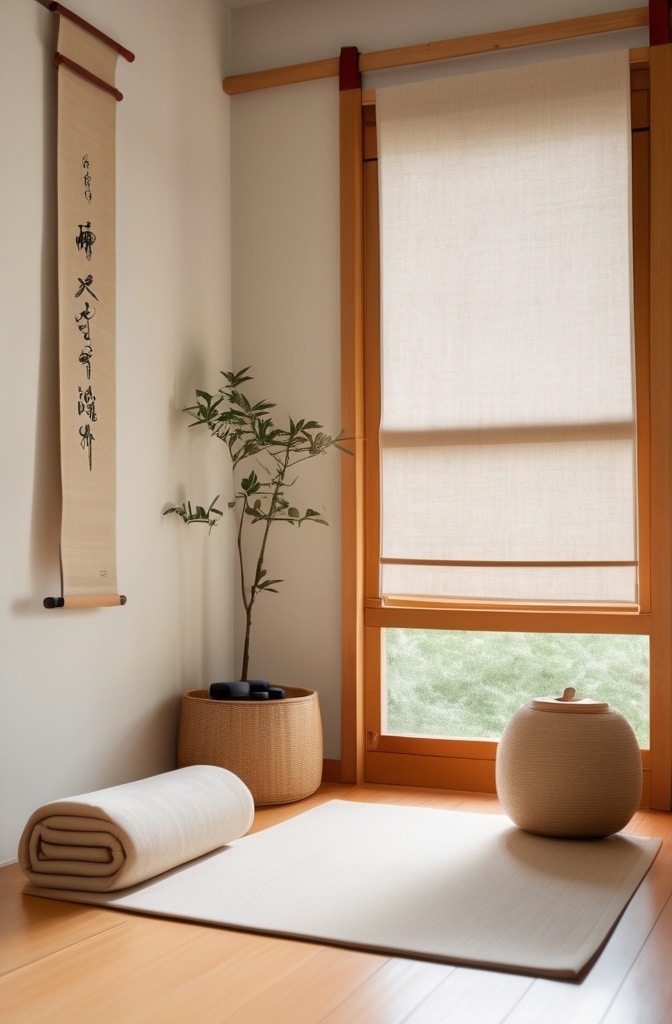
Strategic lighting transforms hallway atmosphere while highlighting your chosen wall decor.
Sconce Selection Based on Hallway Dimensions
Choose fixtures proportionate to your space:
For narrow hallways (under 4 feet wide):
- Slim profile sconces extending no more than 4 inches from wall
- Uplight sconces that direct illumination toward ceiling
- Recessed fixtures with decorative trim plates
For wider hallways:
- Statement sconces that become decorative features
- Paired fixtures on opposite walls
- Larger fixtures with multiple light sources
Lighting designer Marcus Lee recommends, “In hallways, aim for sconces approximately every 8-10 feet. This spacing provides even illumination without creating a ‘runway’ effect that can make corridors feel longer and more institutional.”
Creative Alternatives to Traditional Wall Lighting
Think beyond basic sconces:
- Picture lights that highlight artwork while providing ambient light
- Minimalist LED strips concealed in architectural details
- Pendant clusters hanging at varying heights (in hallways with high ceilings)
- Repurposed vintage items converted to lighting fixtures
- Wall-washing uplights that create dramatic shadow patterns
According to the American Lighting Association, layered lighting approaches (combining ambient, task, and accent lighting) increase perceived spaciousness in hallways by up to 40% compared to single-source lighting.
Energy-Efficient Options for Always-On Areas
Since hallways often require constant low-level lighting:
- Motion-sensor sconces that brighten when someone enters
- Dimmable LED fixtures that can be programmed for time of day
- Smart lighting systems controllable via phone or voice commands
- Solar tubes for daylight harvesting in hallways with roof access
- Low-wattage continuous lighting with supplemental task fixtures
A recent energy efficiency study found that switching hallway lighting to smart LED systems reduced electricity usage in these areas by up to 82% while improving user satisfaction through customized lighting levels.
Statement Art Strategies for Hallway Focal Points
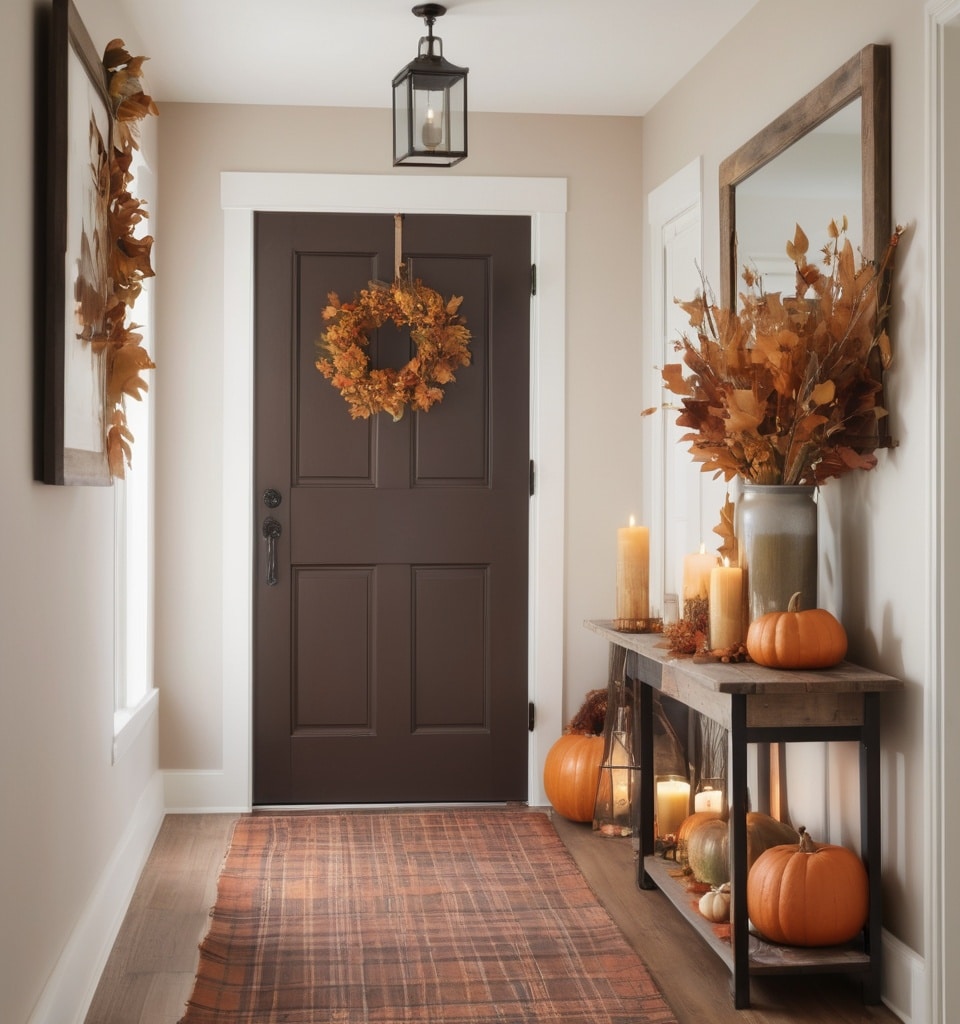
Large-scale art pieces create instant impact in hallways, transforming simple corridors into gallery-like experiences.
Selecting Appropriately Scaled Artwork
Size matters when choosing hallway art:
- Width guideline: Art should be approximately 2/3 to 3/4 the width of the wall or furniture it hangs above
- Height placement: Center of artwork typically 57-60 inches from floor (eye level)
- Long hallways: Series of coordinating pieces rather than one massive work
- Narrow spaces: Vertical orientation pieces that draw the eye up
Art consultant Rebecca Moore advises, “In hallways, where viewing distance is limited, textural and high-contrast pieces tend to work better than subtle or highly detailed works that require close inspection.”
Creating Conversation Starters
Hallway art is uniquely positioned to spark discussion:
- Unexpected subjects that prompt questions or smiles
- Personal interest pieces that reveal homeowner passions
- Local artists’ work that connects to your community
- Rotating displays that change seasonally or with current events
- Interactive or kinetic art that changes with perspective or motion
A trend gaining popularity is the “conversation piece installation,” where art is specifically selected to prompt discussion—particularly valuable in areas where guests naturally pause while moving through the home.
Budget-Friendly Alternatives
Impressive hallway art doesn’t require gallery prices:
- Framed vintage textiles add color and texture
- Engineering prints of digital photos (large format at minimal cost)
- DIY abstract canvases in colors that complement your decor
- Framed wallpaper samples for graphic impact
- Children’s art professionally matted and framed
“The most successful hallway art creates an emotional connection rather than simply filling space,” notes gallery owner Claire Jenkins. “Choose pieces that make you smile every time you pass by, regardless of their price tag.”
Personalizing Your Space: Photo Display Innovations
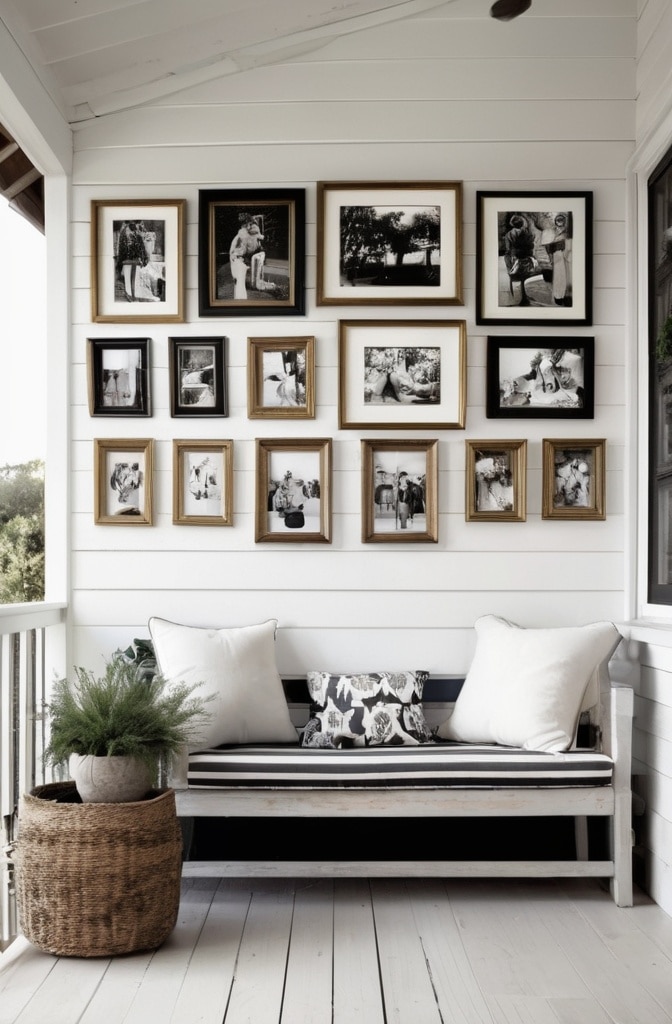
Family photos bring warmth and personality to hallways, but presentation makes all the difference between a thoughtful display and a chaotic collection.
Beyond Basic Photo Walls
Elevate your photo display with these approaches:
- Matching frames with varied mat sizes for unified but interesting displays
- Chronological arrangements that tell your family’s story over time
- Black and white conversions for cohesive visual impact
- Theme-based groupings (travel memories, celebrations, seasonal activities)
- Mixed media presentations combining photos with meaningful objects or text
“Photo displays work best when they follow a clear organizational principle,” advises photographer Emma Stevens. “Whether chronological, thematic, or purely aesthetic, having a system prevents the random ‘refrigerator door’ effect.”
Digital vs. Printed Displays
Consider the pros and cons of different display formats:
Digital Displays:
- Rotate hundreds of images without wall space constraints
- Update remotely via apps or cloud services
- Some frames offer motion sensors to activate when people pass
- Higher initial investment but unlimited content changes
- Require power source and occasional software updates
Traditional Printed Displays:
- No electricity required
- Often more aesthetically pleasing as design elements
- One-time cost (unless you choose to update)
- Physical presence that doesn’t compete for attention
- No technical glitches or updates needed
According to a 2024 home technology survey, digital frame installations in hallways have increased by 45% since 2022, with multi-frame systems becoming particularly popular in family homes.
Creating Visual Narratives
The most compelling photo displays tell stories:
- Life journey walls showing family members at the same age across generations
- Geographic progressions following travels or moves
- Milestone celebrations capturing important life events
- Growth series documenting children at the same location over years
- Seasonal rotations that change with the calendar
Professional photographer Thomas Reed suggests, “The most powerful photo walls combine consistency of presentation with variety of content. This balance creates visual cohesion while maintaining interest for those who pass through daily.”
Bringing Nature Indoors: Plant Wall Strategies
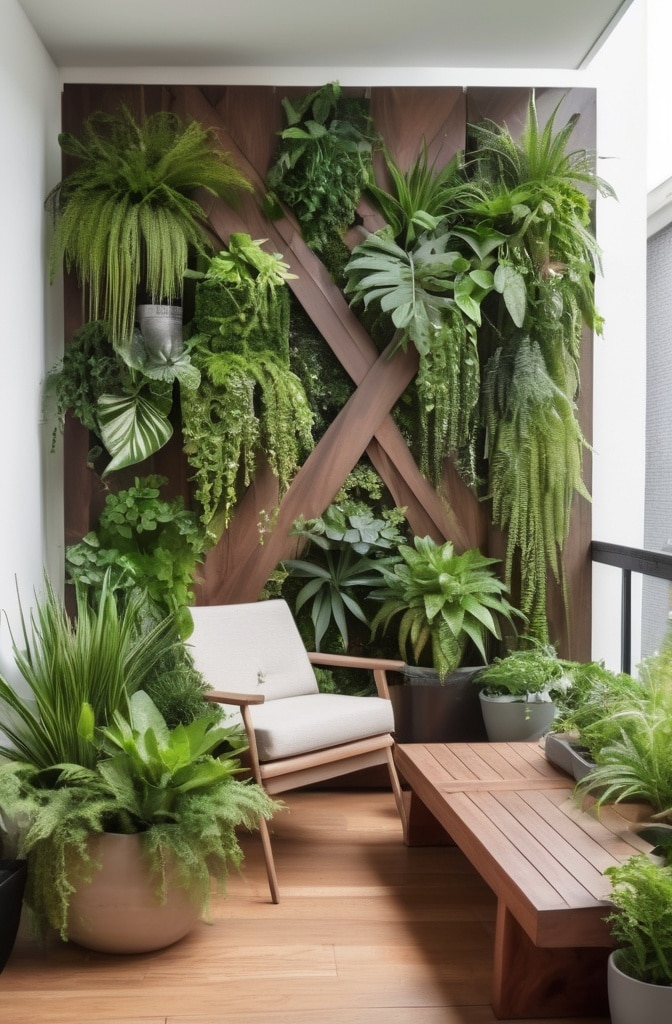
Plants bring life, color, and improved air quality to hallways, but require thoughtful selection and placement in these often challenging environments.
Low-Light Plant Selections for Windowless Hallways
Not all plants need bright conditions to thrive:
- Snake plants (Sansevieria) tolerate low light and infrequent watering
- ZZ plants (Zamioculcas) thrive in almost any condition
- Pothos (Epipremnum) in golden or marble queen varieties
- Chinese evergreen (Aglaonema) offers colorful foliage even in low light
- Cast iron plant (Aspidistra) lives up to its durable name
Botanist Dr. Jennifer Wong notes, “Plants for hallways should be selected primarily for their tolerance of inconsistent conditions rather than their decorative qualities. Fortunately, many of the most resilient species are also visually appealing.”
Vertical Garden Systems for Narrow Spaces
When floor space is limited, grow upward:
- Pocket planters attached directly to walls
- Tiered hanging systems suspended from ceiling hooks
- Wall-mounted grids for climbing plants
- Magnetic planters on metal wall panels
- Vertical hydroponic systems for serious plant enthusiasts
Research from the Environmental Protection Agency indicates that strategically placed indoor plants can improve air quality by up to 25% by removing pollutants and increasing humidity—particularly valuable in typically stuffy hallway spaces.
Maintenance Considerations
Be realistic about care requirements in transitional spaces:
- Watering access: Consider proximity to water sources
- Traffic hazards: Position plants to avoid bumping by passers-by
- Cleaning concerns: Some plants drop leaves or require dusting
- Light levels: Even “low-light” plants need some illumination
- Air flow: Hallways with limited ventilation may affect some species
“The key to successful hallway plantings is honest assessment of your maintenance habits,” advises horticulturist Michael Garcia. “It’s better to choose artificial plants than to subject real ones to neglect in challenging conditions.”
Minimalist Approaches to Hallway Wall Decor
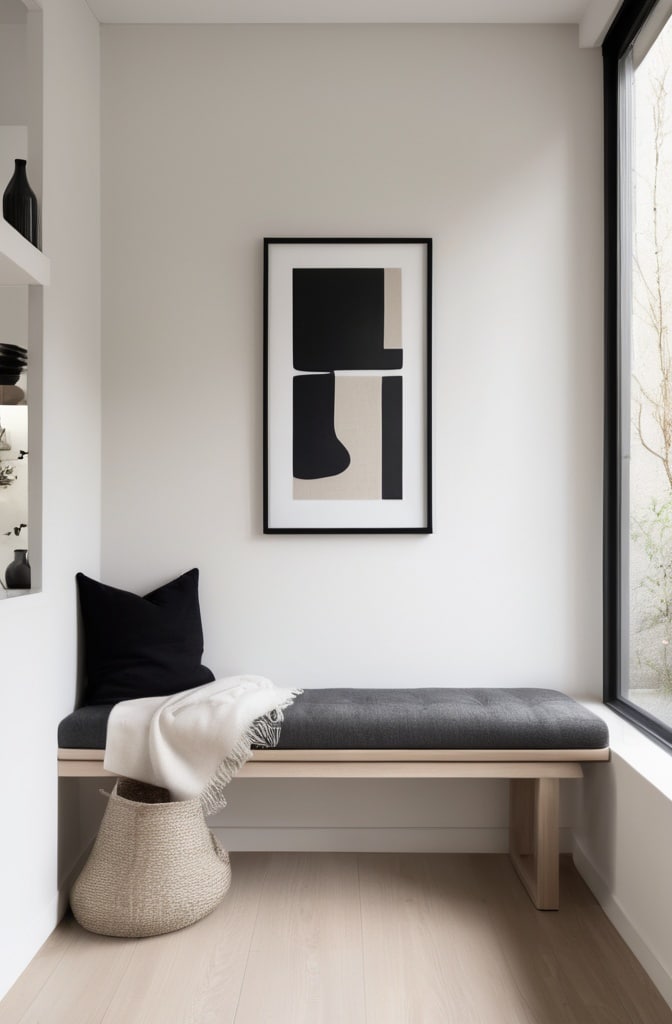
Sometimes less truly is more, especially in narrower hallways where visual clutter can create feelings of confinement.
Core Principles of Minimalist Hallway Design
Embrace minimalism’s fundamentals:
- Intentional negative space as a design element
- Limited color palette (typically 2-3 colors maximum)
- Emphasis on quality over quantity
- Clean lines and simple shapes
- Hidden storage to minimize visual distractions
“Minimalism isn’t about emptiness, but about purpose,” explains design theorist Lisa Chen. “Every element in a minimalist hallway should serve either a functional or meaningful aesthetic purpose—ideally both.”
Creating Impact Through Careful Curation
Minimalist spaces rely on thoughtful selection:
- Single large-scale art piece rather than multiple smaller works
- Statement lighting as both illumination and sculpture
- One distinctive mirror instead of a gallery arrangement
- Limited but meaningful personal artifacts
- Architectural emphasis rather than decorative additions
According to the Institute of Minimalist Design, spaces following minimalist principles are perceived as up to 30% larger than comparably sized spaces with traditional decorating approaches.
Japanese-Inspired Minimalism
Many hallway minimalists draw inspiration from Japanese design:
- Shoji-inspired screening to divide spaces without solid walls
- Natural materials with minimal processing or finishing
- Asymmetrical balance rather than perfect symmetry
- Focused views that draw attention to single elements
- Ma concept (appreciation of negative space between objects)
Interior designer Takashi Yamamoto explains, “In Japanese-inspired minimalism, the hallway becomes not just a path between destinations but a transitional experience that prepares you mentally for the next space. This philosophical approach transforms how we think about hallways entirely.”
Interactive Wall Features for Family Homes
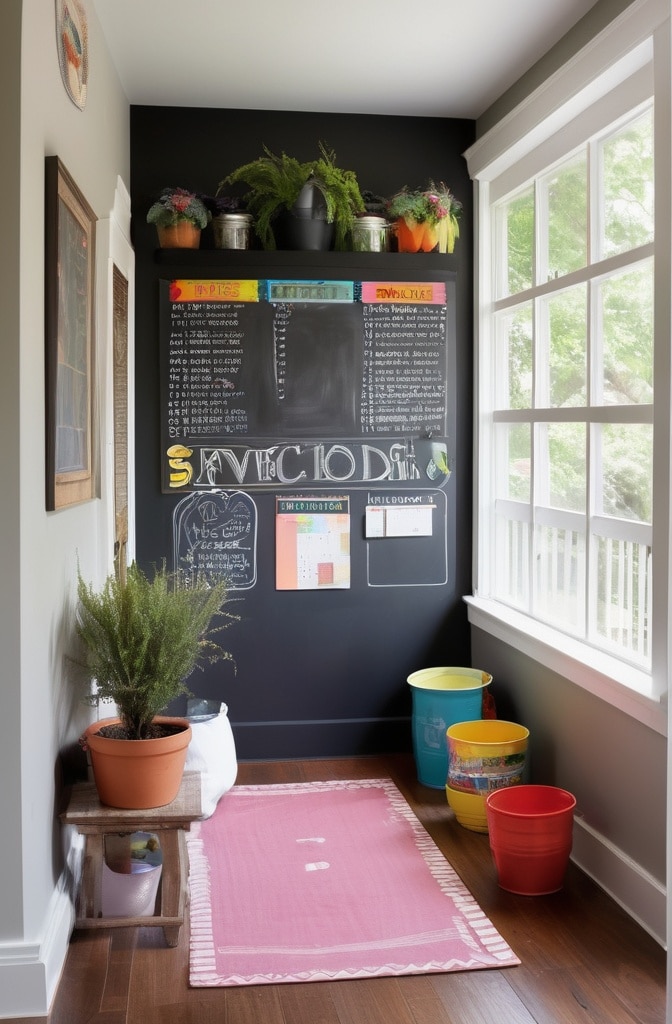
Families with children benefit from hallway elements that encourage interaction and creativity.
Chalkboard Wall Installation and Maintenance
Functional art walls for messages and creativity:
- Paint options: Traditional chalkboard paint vs. newer clear formulations
- Installation area: Consider partial walls or framed sections
- Dust control: Placement away from vents and strategic use of chalk ledges
- Maintenance: Regular cleaning with appropriate solutions
- Design integration: Framing techniques to make it look intentional
Family psychologist Dr. Amanda Richards notes, “Interactive walls in hallways create ‘pause points’ that transform purely transitional spaces into areas of family connection and communication. These small daily interactions build stronger family bonds.”
Magnetic Surfaces for Flexible Displays
Create constantly evolving wall features:
- Magnetic paint beneath regular wall color
- Sheet metal panels disguised with decorative frames
- Magnetic strips integrated into wall designs
- Display options: Children’s artwork, family schedules, photos
- Organization systems using magnetic containers and clips
According to a 2024 family living survey, homes with interactive wall features reported 60% more frequent family communication and significantly higher satisfaction with shared living spaces.
Growth Charts That Enhance Design
Document growth while adding visual interest:
- Built-in measuring features in wall treatments
- Artistic interpretations of traditional height markers
- Removable options that can relocate if you move
- Photo integration combining measurements with yearly pictures
- Multi-generational charts for extended family history
Designer and parent Michelle Parker shares, “The most successful family hallway features serve multiple purposes—documenting memories while adding beauty, encouraging creativity while maintaining organization. When form and function merge perfectly, that’s when magic happens.”
Metal Accents and Sculptural Elements
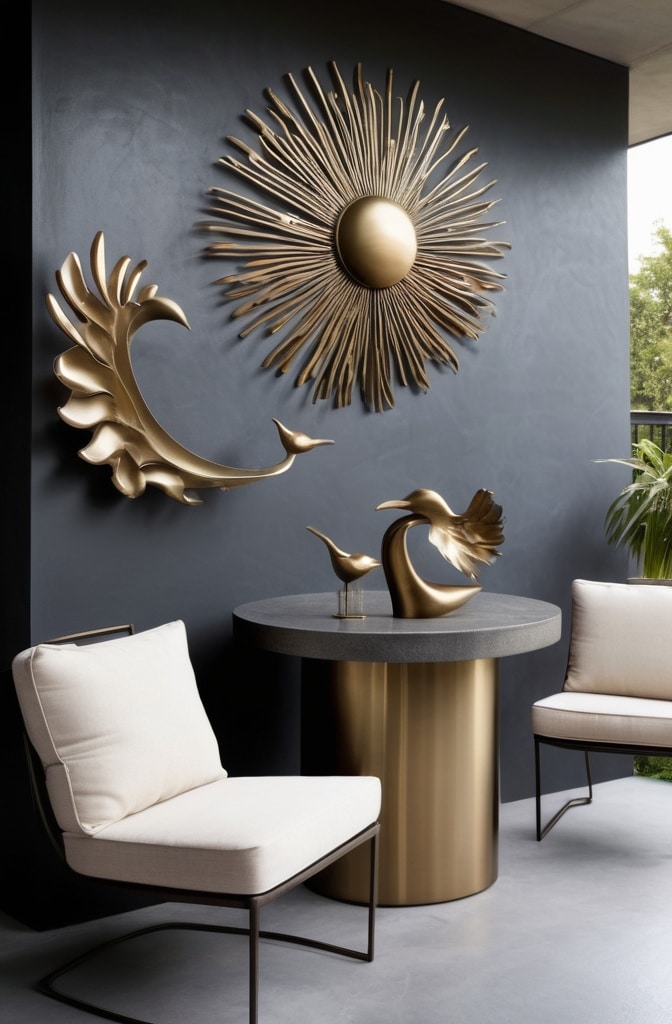
Three-dimensional wall decor adds sophisticated visual interest through shadow play and texture.
Incorporating Dimension Through 3D Wall Art
Break away from flat wall treatments:
- Metal wall sculptures create dynamic shadows as lighting changes
- Dimensional panels add architectural interest
- Layered art installations create depth perception
- Shadow box displays for collected objects
- Textural art using mixed materials and varying heights
“Dimensional wall art essentially becomes architecture in hallways with limited floor space for sculptural objects,” explains gallery curator Sebastian Ross. “These pieces transform flat surfaces into dynamic, changing experiences as you move through the space.”
Metal Finish Selection
Different metal finishes create different effects:
- Brushed brass adds warmth and subtle gleam
- Antiqued silver creates vintage sophistication
- Blackened steel offers industrial edge
- Copper brings rich color that develops patina over time
- Mixed metals create collected, eclectic feeling
According to the Metal Arts Guild, metal wall installations have seen a 35% increase in popularity since 2022, with custom pieces created specifically for hallway dimensions becoming a growing trend among homeowners seeking unique design elements.
Installation Considerations for Heavier Elements
Safety first with substantial wall decor:
- Locate studs or use appropriate anchors rated for the weight
- Consider traffic flow and head clearance in narrow passages
- Plan for removal/replacement if you might relocate pieces
- Check for interference with doors, light switches, or other functional elements
- Allow appropriate viewing distance for larger pieces
Professional installer Marcus Johnson advises, “For every pound of wall art, ensure you’re using mounting hardware rated for at least twice that weight. Hallways experience more vibration from foot traffic than other spaces, making secure installation particularly important.”
Heritage and Travel-Inspired Wall Decor

Personal history and adventures provide rich material for meaningful hallway displays.
Map Displays With Personal Significance
Maps offer both decorative appeal and storytelling opportunities:
- Vintage maps of ancestral homelands
- Push pin travel maps documenting journeys
- Custom-created maps highlighting significant locations
- Topographical maps of favorite landscapes
- Historical maps showing family migration patterns
“Maps in hallways serve as both art and conversation starters,” notes travel writer Elena Rodriguez. “They transform mundane walls into stories of where you’ve been and where you dream of going.”
Creating Travel Galleries
Showcase your adventures with cohesive displays:
- Shadow boxes with small souvenirs and photos
- Similar frames with images from different destinations
- Themed collections (architectural details, local food, landscapes)
- Before/during/after triptychs of transformation journeys
- Maps with radiating photo arrangements showing locations visited
Research from the Travel Photographers Association suggests that displaying travel memories prominently in the home extends the psychological benefits of travel by up to 40%, creating “micro-moments” of remembered joy during everyday activities.
Cultural Artifacts as Wall Decor
Incorporate meaningful objects from different cultures:
- Woven textiles mounted in frames or on rods
- Masks or ceremonial objects appropriately displayed
- Musical instruments as functional art
- Hand-crafted baskets arranged in wall groupings
- Cultural symbols respectfully incorporated into designs
Cultural anthropologist Dr. Michael Chen cautions, “When displaying items from other cultures, research their significance and display them respectfully. The most meaningful displays honor the cultures represented rather than simply using objects as exotic decoration.”
Specialty Wall Treatments for Dramatic Impact
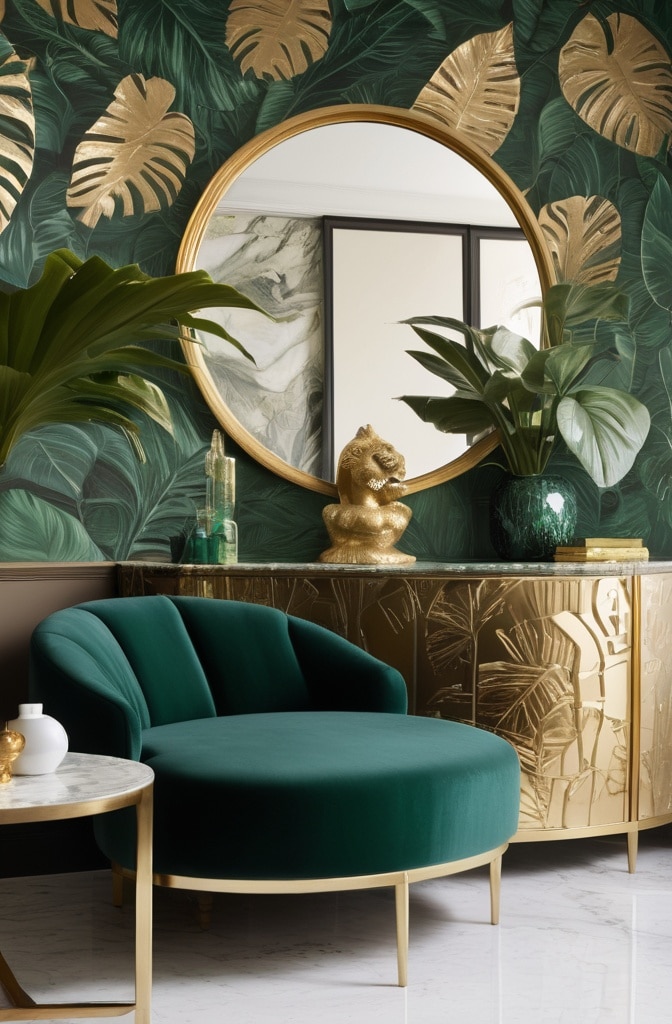
For those seeking truly distinctive hallways, specialty wall treatments create unforgettable impressions.
Wallpaper Selection for High-Traffic Areas
Modern wallpapers offer durability with style:
- Vinyl wallcoverings stand up to scuffs and can be wiped clean
- Grasscloth adds natural texture but works best in lower-traffic zones
- Commercial-grade papers designed specifically for high-wear areas
- Peel-and-stick options for easier replacement if damaged
- Washable papers with protective coatings
Wallpaper designer Elizabeth Morgan notes, “Hallways actually make perfect showcases for bold wallpaper choices. Since you pass through rather than linger, you can enjoy more dramatic patterns without feeling overwhelmed by them.”
Application Strategies for Challenging Dimensions
Use wallpaper to visually alter proportions:
- Horizontal stripes make narrow hallways appear wider
- Vertical patterns emphasize height in low-ceiling areas
- Large-scale patterns can make short hallways seem longer
- Ombre effects create depth perception
- Ceiling application draws the eye upward
According to a 2024 interior design survey, hallways are now the third most popular location for specialty wallpaper installation, behind only powder rooms and dining areas.
Bold Pattern Approaches
Make a statement with dramatic patterns:
- Geometric designs create modern, energetic feelings
- Botanical patterns bring nature indoors
- Abstract designs add artistic flair
- Trompe l’oeil effects create architectural illusions
- Custom-printed papers featuring family photos or meaningful imagery
“Pattern selection for hallways should consider viewing angles and duration,” advises interior designer James Wilson. “Patterns look different when viewed head-on versus obliquely as you walk past them, an important consideration in passage spaces.”
Budget-Friendly Hallway Transformations
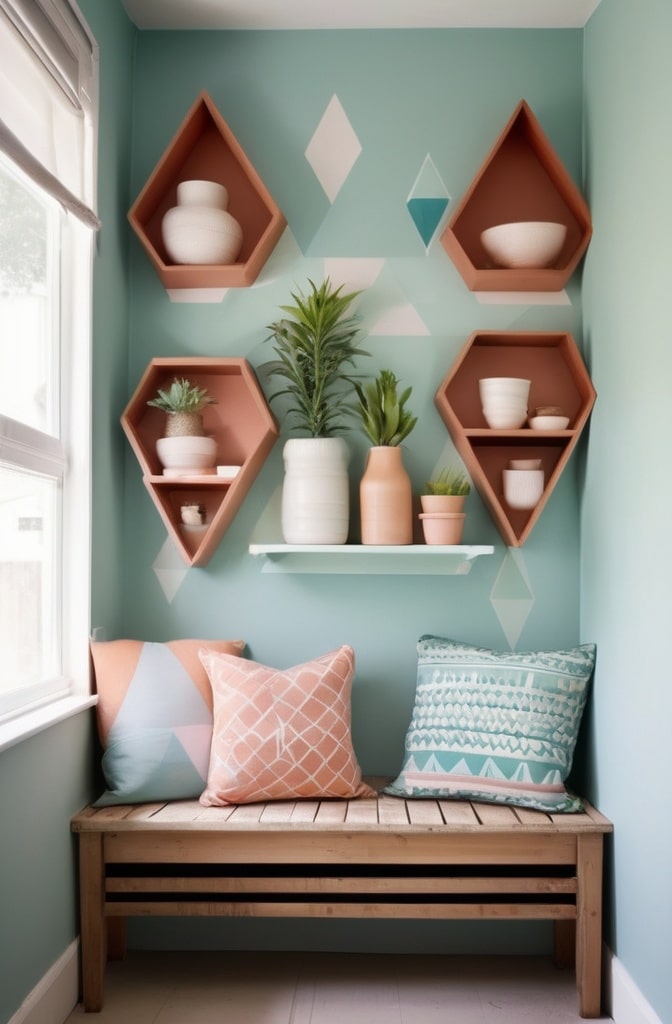
Creating impact doesn’t require a massive investment when approached strategically.
High-Impact, Low-Cost Solutions
Transform your hallway without breaking the bank:
- Paint techniques like color blocking or stenciling
- Repurposed items from thrift stores given new life
- Family photos in uniform inexpensive frames
- DIY wall art created with simple materials
- Removable wall decals for temporary impact
Home economist Rachel Turner shares, “Some of the most striking hallways I’ve designed cost under $200 to transform. Strategic use of paint and thoughtful arrangement of existing items can create dramatic before-and-after results without significant investment.”
Thrift Store and Marketplace Finds
Learn what to look for in second-hand shopping:
- Vintage mirrors often available at fraction of new prices
- Art frames (even if the art itself isn’t to your taste)
- Wall sconces that can be rewired or repainted
- Decorative plates or platters for wall arrangements
- Architectural salvage pieces with character and history
According to a 2023 decorating cost analysis, thrifted hallway decor items averaged 70-85% less than comparable new items, with vintage mirrors offering the greatest savings compared to new equivalents.
Phased Approach to Transformation
Break projects into manageable stages:
- Foundation phase: Paint and basic lighting
- Statement piece phase: One impactful mirror or artwork
- Functional addition phase: Hooks, small storage, or shelving
- Personalization phase: Photos and meaningful items
- Refinement phase: Additional decorative elements and lighting
“Start with changes that create the biggest visual impact for the least money,” suggests budget decorator Maria Lopez. “A fresh paint color and updated light fixture immediately transform the space, creating a foundation for other changes as budget allows.”
Seasonally Adaptable Wall Decor Systems
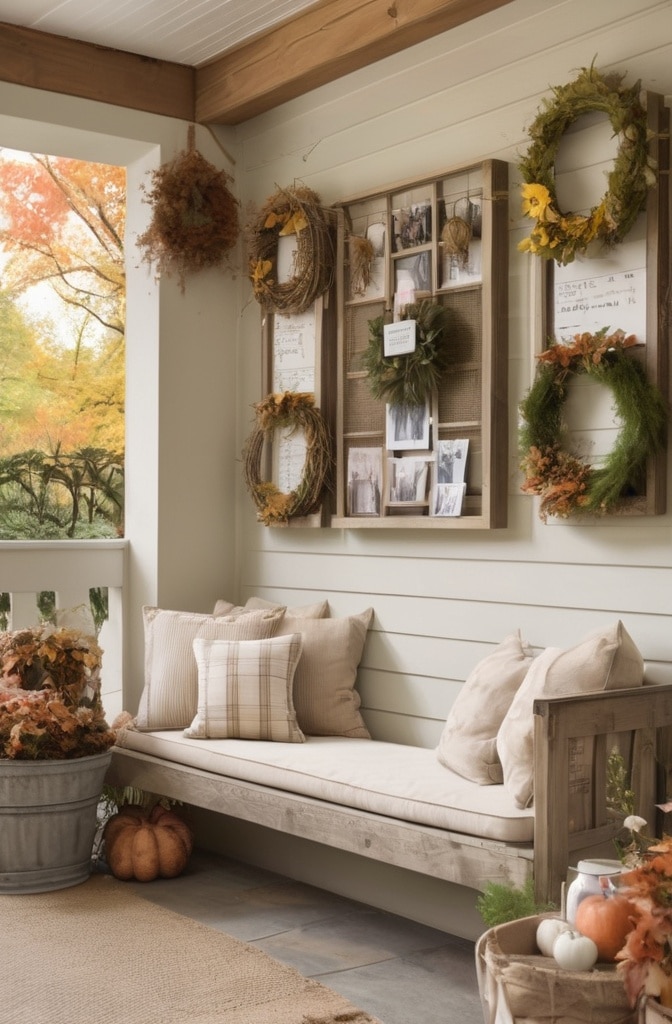
Create hallways that evolve throughout the year to keep spaces feeling fresh and relevant.
Creating Flexible Display Areas
Build adaptability into your hallway design:
- Gallery rails allowing for easy art swapping
- Shadow box shelves with seasonal contents
- Magnetic or cork strips behind decorative frames
- Display ledges for rotating objects
- Grid systems with adjustable components
Professional stager Jennifer Adams notes, “Homes that incorporate seasonal adaptability feel more alive and responsive. Even small changes reflect attention to detail that guests notice subconsciously.”
Holiday-Specific Strategies
Prepare for seasonal transitions:
- Install subtle hooks for wreaths or garlands
- Create “anchor points” where seasonal items can attach
- Reserve wall space for special occasion displays
- Use neutral backgrounds that complement different holiday colors
- Install picture lighting that can highlight different seasonal displays
A recent design survey found that homes with built-in seasonal display features reported 40% more frequent decor changes and significantly higher satisfaction with their spaces compared to homes without these flexible systems.
Quick-Change Elements
Some items are particularly suited to seasonal rotation:
- Textile wall hangings in seasonal colors or patterns
- Botanical displays reflecting current season
- Framed prints in interchangeable frames
- Message boards with seasonal content
- Light filters or gels that change ambient lighting colors
“Creating a seasonally responsive home doesn’t require storing endless decorations,” explains organization expert David Chen. “A few well-chosen, high-impact pieces for each season create transformation without overwhelming storage spaces.”
Smart Tech Integration in Hallway Wall Design

Modern hallways can incorporate technology that enhances both function and aesthetics.
Digital Displays and Smart Features
Technology for today’s connected homes:
- Digital art frames rotating collections of images
- Motion-activated lighting integrated with wall decor
- Smart home control panels designed as decorative elements
- Projection systems displaying changing imagery
- Voice-controlled elements adjusting lighting or music
According to the Smart Home Association, hallways are increasingly becoming “command centers” for home technology, with 62% of new smart home installations including hallway-based control systems.
Hidden Tech Solutions
Technology that doesn’t disrupt traditional aesthetics:
- Speakers concealed behind art canvases
- Charging stations integrated into decorative shelving
- Motion sensors disguised as architectural elements
- Smart lighting hidden within crown molding
- Digital displays behind two-way mirrors
Tech integration specialist Marcus Williams advises, “The most successful smart hallways don’t look ‘techy’ at all. The technology should enhance the experience without becoming the focal point unless that’s specifically the design intention.”
Future-Proofing Your Design
Prepare for evolving technology:
- Install extra power outlets behind wall decor for future needs
- Consider conduit placement for future wiring requirements
- Use removable panels for access to infrastructure
- Choose systems with open standards rather than proprietary technologies
- Plan for technology obsolescence with easily replaceable components
Frequently Asked Questions
How do I choose the right scale of art for my hallway walls?
Choose art that takes up about two-thirds of available wall space, with smaller pieces for narrow hallways and larger statements for wider spaces.
What lighting options work best for highlighting hallway wall decor?
Picture lights, track lighting, recessed fixtures, LED strips behind frames, and smart lighting systems all effectively showcase hallway decor while adding ambiance.
How can I incorporate technology into my hallway without it looking cluttered?
Select minimalist tech designs with dual purposes, use flush-mounted panels, and conceal wiring behind walls for a clean, integrated look.
What wall treatments work best in high-traffic hallways?
Durable options like washable paint, vinyl wallpaper, wood paneling, or tile wainscoting resist scuffs and clean easily in busy hallway spaces.
How do I create a cohesive look when decorating a hallway that connects different rooms?
Use a neutral base with elements from each adjacent room, maintaining consistent frames or color themes while varying artwork or textures to create flow.
Conclusion
Transforming your hallway with thoughtful wall decor and smart technology integration creates a space that balances aesthetics with functionality, setting the tone for your entire home while serving practical purposes.
